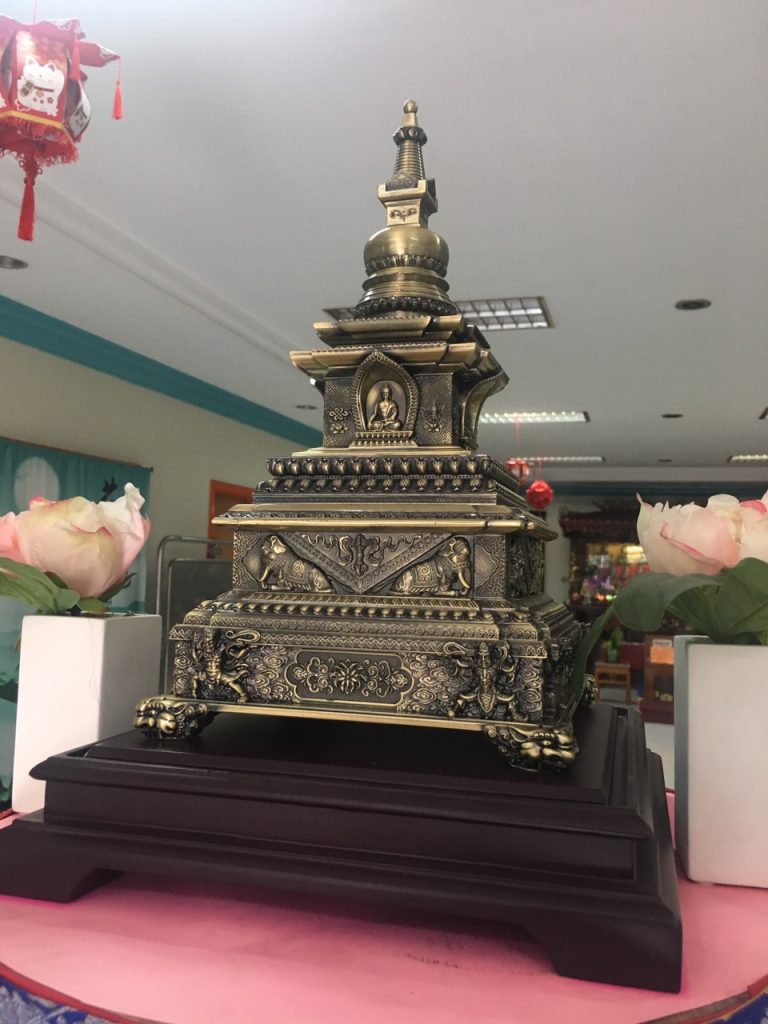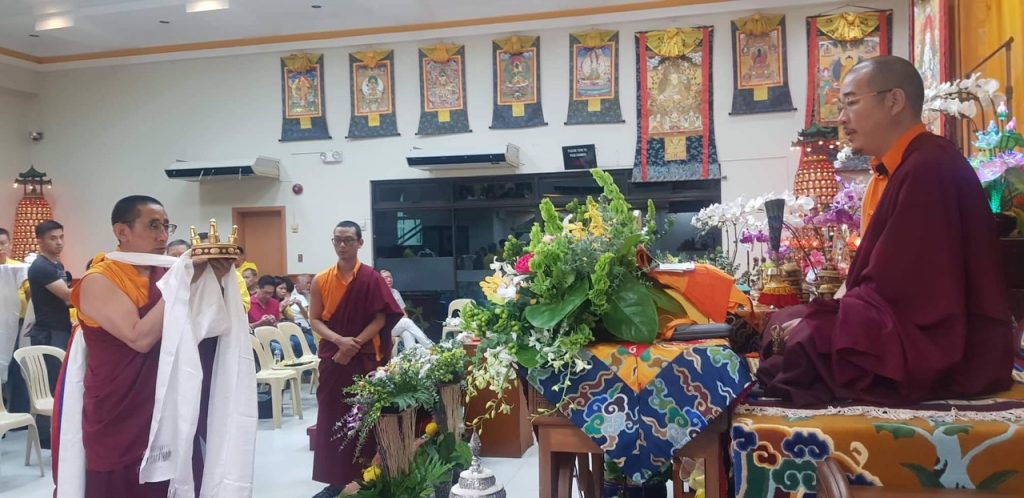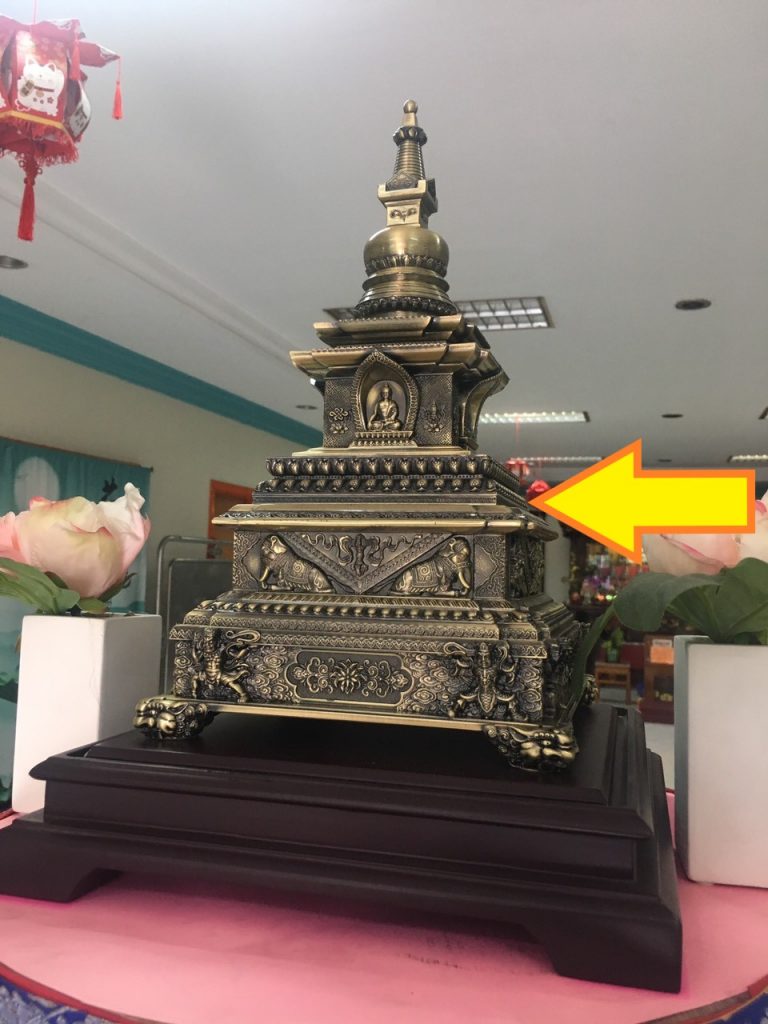Represents the Mind of the Buddha
by Khenpo Tashi
I want to talk about the Stupa. Because normally, when people come into the temple, they know the Buddha statues. They recognize what the statues are.
But then, when they see the Stupa, they may think, “Huh? What is that?” Then, surely, they will also not know what to do with it. But the Stupa is very, very important!
Sometimes, I hear people think that the Stupa is some invention by the Indian or Tibetan culture, not really from the Buddha. Haha! See, we don’t know what it is, then we also don’t know where it originated from. How can we continue?
The Stupa As Mind of the Buddha
The Stupa represents the mind of the Buddha. Usually, we say in Tibetan, ku sung thuk, or Holy Body, Speech and Mind of a Fully Awakened, Perfect Buddha. What represents the Buddha’s body? The Buddha statue. The Buddha’s speech? The text or Sutra volumes. The mind? —- The Stupa.
So the Stupa represents the Buddha’s fully awakened mind.

After a formal ceremony, such an empowerment or a grand teaching, we need to offer something to the presiding master. You will see a line of offerors. The first offeror at the beginning of the line offers a mandala.
Then, the next three people behind him hold three special objects – the representations of Body, Speech and Mind of Buddha. The Stupa is offered as a representation of the Buddha’s Mind.


The Origin of the Stupa
The mind of the Buddha is something very extraordinary, unfathomable.
Where did the Stupa symbol come from? I don’t know exactly. But definitely even before Buddha Shakyamuni’s time.
In the Sutras, he already mentioned the Stupa several times. In the Fortunate Eon Sutra that he taught, he mentioned the Stupa.
This Sutra is about the 1,004 Samyaksambuddhas of this Fortunate Eon. Buddha Shakyamuni is only the fourth amongst them.
Using his clairvoyance, Buddha Shakyamuni predicted the eventual arrival of all these Buddhas, who their families will be, the names of their parents, their foremost disciples and so on. In another chapter of that Sutra, he also recounted how and when each of these future Buddhas first generated the great Mind of Enlightenment (Bodhicitta) as an ordinary person.
One future Buddha, when he was just an ordinary person in the past, offered with strong faith to the Stupa of a past Buddha.
That person did not meet that Buddha because that Buddha already passed away into Mahaparinirvana. But, from bowing to that Buddha’s Stupa alone, this man was able to generate great merit.
(The quote is added below)
The 101st Buddha of the future, O-thro, first generated the desire to become a Buddha when, as a doctor then, he offered an incense pastil to the Stupa of the Buddha Kye-wo.
Buddha Shakyamuni, Fortunate Eon Sutra
So, the Stupa is a symbol from a very long time ago.
Transforming into the Buddha’s Mind
The second important thing about the Stupa is, “How does it represent the mind of the Buddha?”
To become a Perfectly Enlightened Buddha, one must practice the Mahayana, the Great Vehicle. In the Mahayana, there are 37 Factors of Enlightenment, 37 very wholesome qualities to be developed in one’s mind, before one can reach the summit – the state of Buddhahood.
These 37 Factors are found as the 37 steps on the Stupa, from its base to the top. When an ordinary mind develops these 37 factors, it will turn into a Buddha-mind. Having these 37 factors in the Stupa, that is how the Stupa represents the Buddha’s mind.
The Stupa starts from here, (pointing to a level), since there is still a throne under the Stupa. The throne, below this base, is not a part of the Stupa. It is usually included to raise something precious – the Stupa.
So, in the future, please treat the Stupa with great respect, as if it is the mind of the Buddha, with all its excellent and unsurpassed qualities and powers. (READ: The Three Aspects of the Buddha’s Mind)

________________
The 37 Factors of Enlightenment
(from Rigpawiki https://dhammawiki.com/index.php/37_factors_of_enlightenment)
The 4 Foundations of Mindfulness
- Mindfulness of body
- Mindfulness of sensations
- Awareness of mind
- Meditation on the Dhamma
The 4 supreme efforts
- Not to let an unwholesome thought arise which has not yet arisen.
- Not to let an unwholesome thought continue which has already arisen.
- To make a wholesome thought arise which has not yet arisen.
- To make a wholesome thought continue which has already arisen.
The 4 means to accomplishment
- Desire, zeal (wholesome)
- Energy
- Consciousness
- Investigation
The 5 strengths
- Faith
- Energy
- Mindfulness
- Concentration
- Wisdom
The 5 faculties
- Faith
- Energy
- Mindfulness
- Concentration
- Wisdom
The Noble Eightfold Middle Path
- Right Understanding
- Right Thought
- Right Speech
- Right Action
- Right Livelihood
- Right Effort
- Right Mindfulness
- Right Concentration
The 7 factors of enlightenment
- mindfulness
- investigation of mental phenomena
- energy
- joy
- tranquillity
- concentration
- equanimity
